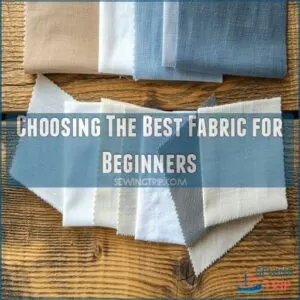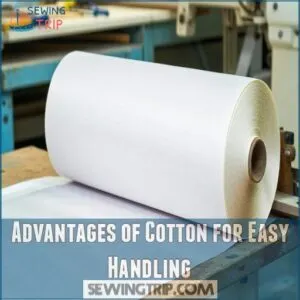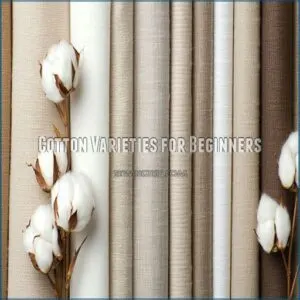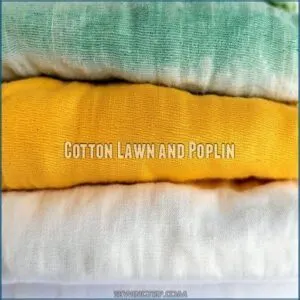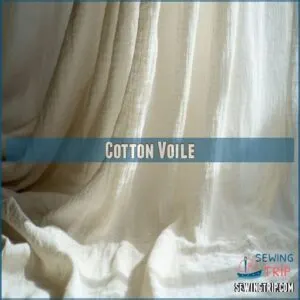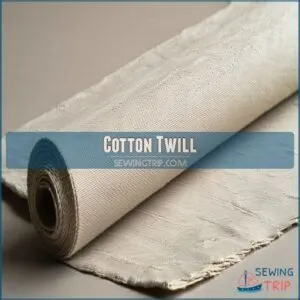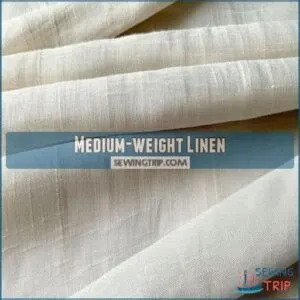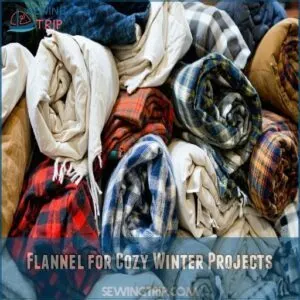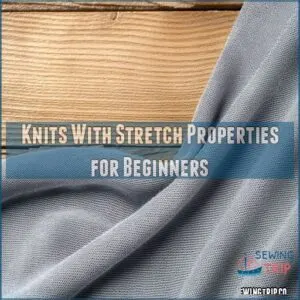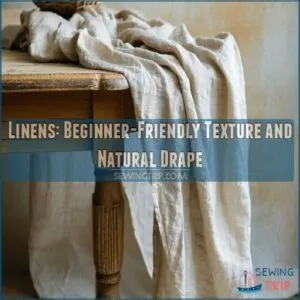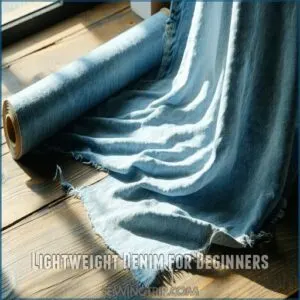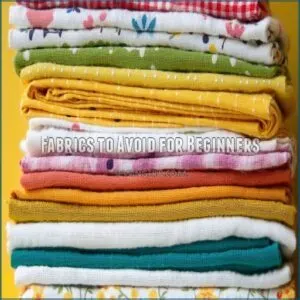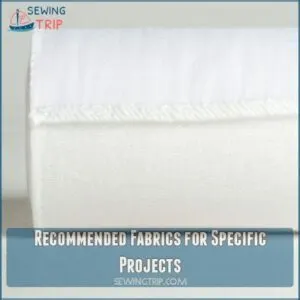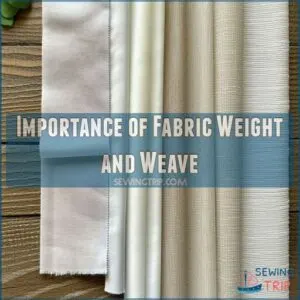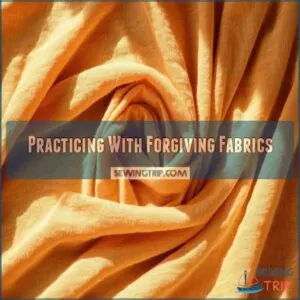This site is supported by our readers. We may earn a commission, at no cost to you, if you purchase through links.
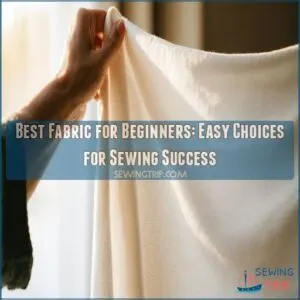
Finding the best fabric for beginners is key.
Cotton’s your best friend—it’s easy to work with and forgiving.
Think comfy t-shirts, not slippery silks!
Linen’s another great choice, offering a lovely drape, though it wrinkles.
Avoid anything too delicate or stretchy at first;
you want something that won’t fight back.
Mastering basic fabrics builds confidence.
We’ll explore more options and specific project ideas, but for now, grab some cotton—you’ve got this!
Trust me, choosing the right fabric makes all the difference.
Table Of Contents
- Key Takeaways
- Choosing The Best Fabric for Beginners
- Cotton as The Go-to Fabric for Beginners
- Beginner-Friendly Fabrics Beyond Cotton
- Knits With Stretch Properties for Beginners
- Linens: Beginner-Friendly Texture and Natural Drape
- Lightweight Denim for Beginners
- Fabrics to Avoid for Beginners
- Recommended Fabrics for Specific Projects
- Importance of Fabric Weight and Weave
- Practicing With Forgiving Fabrics
- Frequently Asked Questions (FAQs)
- Conclusion
Key Takeaways
- You’ll find cotton is your best friend; it’s easy to handle, doesn’t slip, and is perfect for honing your sewing skills.
- Stick with medium-weight and stable weave fabrics for beginner-friendly projects; they’ll help you avoid frustrating mishaps.
- Avoid slippery, delicate, or heavily textured fabrics like silk or velvet; they complicate the learning process and can cause quilting headaches.
- Explore simple projects like blouses and skirts with versatile fabrics like cotton poplin; they offer forgiving textures that boost your confidence.
Choosing The Best Fabric for Beginners
When you’re just starting out in sewing, choosing the right fabric can make or break your experience, so stick with stable, easy-to-handle fabrics like cotton that won’t cause headaches.
Avoid materials that are slippery or delicate, like silk, and you’ll set yourself up for sewing success with much less frustration.
What to Look for in a Beginner-Friendly Fabric
Picking the right fabric for beginners is like choosing the best shoes for a dance—start with materials that offer comfort and control.
Look for fabrics with a medium weight and smooth texture, like cotton, for easy handling.
Opting for sturdy quilting cotton makes sure you have a versatile and forgiving fabric for a wide range of projects.
Avoid slippery surprises.
Opt for a stable weave, making sure you have forgiving fabrics that help you master your sewing skills.
Importance of Fabric Stability
Fabric stability’s your new best friend for sewing beginners.
Think of it as your project’s backbone, preventing bias stretching and seam slippage.
You want fabrics that keep their shape without pesky distortions.
They make life easier, so you’re not battling with wobbly edges.
Stable fabrics are your trusty sidekick, ensuring smooth sailing on your sewing journey.
Avoiding Delicate and Slippery Fabrics
When you’re picking your first fabrics, steer clear of delicate and slippery ones like silk satin and velvet.
These can turn your sewing joy into a frustrating slip-and-slide.
Instead, opt for stable fabrics that you can easily handle.
Overcoming these sewing challenges gives you more freedom and control, letting your creativity shine without fabric-induced headaches.
Cotton as The Go-to Fabric for Beginners
When you’re just starting out, cotton is your best friend thanks to its easy handling and versatility.
From crisp cotton poplin to soft cotton voile, these fabrics won’t slip around on you, making them perfect for honing your sewing skills.
Advantages of Cotton for Easy Handling
So, you’re diving into sewing? Cotton’s your best friend!
Its smooth texture makes it a dream to work with. You’ll love how easily it presses—no wrestling with wrinkles here. Minimal fraying means less fuss, and its forgiving nature lets you relax.
Plus, the wide color range lets your creativity shine.
With cotton fabric, you’ll master sewing in no time!
Cotton Varieties for Beginners
Cotton’s wide range beckons beginners with open arms.
From the crisp feel of cotton voile to the sturdy goodness of cotton twill, there’s a type for every budding seamstress.
Each variety offers different textures and weights, ensuring that sewing stays simple and enjoyable.
You’ll soon find that cotton fabric provides a smooth path toward mastering your sewing skills.
Cotton Lawn and Poplin
Looking to sew your first project? Cotton lawn and poplin are your best friends.
These fabrics are easy to handle, won’t stretch, and press like a dream.
Perfect for blouses or summer dresses, they pair well with simple patterns.
Plus, they’re available in a rainbow of colors.
Give them a try, and watch your sewing skills flourish!
Cotton Voile
If you’re up for some lightweight creations, cotton voile is a top pick.
Its crisp, smooth texture makes it an easy choice for blouses and summer dresses, offering a breezy flow that’s simple to sew.
You’ll love how voile behaves on the machine, rarely fraying.
Embrace its versatility in beginner sewing projects for a satisfying start.
Cotton Twill
Switching from the crisp, smooth cotton voile, cotton twill stands out with its diagonal weave and durability.
This fabric is your buddy for structured projects, offering strength and ease.
You’ll find cotton twill:
- Sturdy yet flexible for beginner-friendly sewing
- Perfect for pants and jackets
- Available in versatile weights
- Easy to maintain and care for
Enjoy the journey!
Beginner-Friendly Fabrics Beyond Cotton
If you’re ready to explore beginner-friendly fabrics beyond cotton, consider trying materials like linen, chambray, and flannel, which each offer unique qualities for easy sewing.
Linen’s breathable nature, chambray’s lightweight charm, and flannel’s cozy warmth, you’ll find these fabrics are great alternatives that keep both your sewing machine and creativity humming.
Linen for Beginners
You’re ready to start working with linen! It’s perfect for beginners with its forgiving nature and beautiful drape. Picture it like this:
| Linen Care Tips | Linen Project Ideas |
|---|---|
| Gentle wash | Summer tunics |
| Avoid tumble dry | Flowing skirts |
| Iron damp | Relaxed pants |
| Store hung | Simple tops |
| Avoid harsh sun | Tote bags |
Jump into your first linen project and feel the difference!
Medium-weight Linen
Ready to conquer linen? Medium-weight linen’s your friend! It’s strong enough to handle your first projects, yet forgiving enough to let you learn.
This weight drapes beautifully—think flowy skirts or breezy tops.
Remember proper linen care, though; it wrinkles, but that’s part of its charm! Explore linen projects knowing you’ve picked a winner among easy sew fabrics. It’s a fantastic choice for beginner-friendly fabrics.
Chambray as a Summer Weight Alternative
Chambray is your go-to when you want a summer-friendly twist on denim.
It’s lightweight, breathable, and super easy to work with, making it perfect for beginners.
Unlike denim, chambray boasts a softer, more forgiving texture in delightful shades, easing you into the joys of sewing.
Whether it’s a breezy dress or relaxed shirt, chambray offers endless summer possibilities.
Flannel for Cozy Winter Projects
Flannel’s your go-to for cozy winter projects that feel like a warm hug.
This beginner-friendly fabric is soft, easy to sew, and forgiving.
To minimize residual shrinkage and make sure your projects turn out as expected, allow for 5-10% shrinkage when cutting and sewing flannel, and consider prewashing flannel tips.
Choose medium-weight flannel for durability.
Pre-wash to prevent shrinking.
Try simple patterns like scarves or pajama pants.
Use a sharp needle for clean cuts.
Knits With Stretch Properties for Beginners
When you’re just starting out with sewing, knits with stretch properties like double knit (ponte knit) can be your best friend, as they’re forgiving but also easier to manage.
They offer a comfy fit and the stretch makes it super easy to tackle projects, bringing a smile when those stitches turn out just right!
Double Knit (Ponte Knit) for Easy Sewing
Double knit, like the versatile ponte knit, is your go-to for easy sewing projects. It holds its shape with minimal fuss, making it ideal for rookies. Just imagine crafting comfy skirts or jackets without stress!
| Ponte Knit | Characteristic | Tip |
|---|---|---|
| Drape | Structured | Perfect for fitted garments |
| Care | Low maintenance | Machine wash and dry |
| Sewing | Beginner-friendly | Use a stretch needle |
| Projects | Versatile designs | Try skirts or blazers |
| Alternatives | Explore thicker knits | Ideal for more warmth |
Benefits of Knits for Beginner Sewers
Opting for knits is like finding a fabric friend who’s got your back while you learn.
Knit fabrics stretch and offer easy comfort, meaning they’re more forgiving with seams and less likely to fray.
Perfect for sewing beginners looking for easy-to-work-with fabrics, knits like jersey are the ultimate choice for creating easy-to-fit, comfortable wear.
Choosing Stable Knits With Good Stretch Recovery
Choosing knits with good stretch recovery can make or break your sewing project.
To make things easy, look for fabrics that return to their original shape after stretching.
Here’s what to keep an eye on:
- Jersey Knit: Soft and comfy.
- Ponte Knit: Holds structure well.
- Fabric Weight: Balance drape and durability.
- Care Instructions: Easy washing is a bonus!
Linens: Beginner-Friendly Texture and Natural Drape
You’ll love working with linen; its texture is surprisingly easy to manage, even for a beginner.
Linen is more forgiving than you might think!
That beautiful natural drape makes it perfect for breezy summer projects.
Linen for Summer Garments
When tackling summer projects, linen is your best friend.
This fabric, a natural fiber, is light, breathable, and perfect for warm weather clothes.
Sewing with linen gives your garments that effortless vibe while offering great practice with natural fibers.
Remember, it’s all about finding the right linen fabric weight and color choices for that ultimate sunny day outfit.
Natural Wrinkles and Character
Linen’s natural fibers give it a texture that tells its own story, complete with charming wrinkles.
You might think they’re pesky, but those crinkles add character to every piece you make.
To minimize wrinkles, you can opt for cotton linen blends.
Embrace linen’s drape and beauty—it’s like nature’s own stamp of authenticity.
Just a bit of ironing, and you’re set, keeping it looking effortlessly cool and stylish.
Forgiving With Practice
Facing sewing mistakes with forgiving fabrics like linen eases your learning curve.
You can explore various options at linen fabric stores like linen fabric shops.
It’s like a gentle nudge in the right direction, helping you experiment without fear.
Linen’s texture and drape mean your fabric choices aren’t just beginner-friendly; they’re confidence-building.
So, while choosing patterns, remember that practice makes perfect and linen lets you master those bumps gracefully.
Lightweight Denim for Beginners
Lightweight denim is your best friend when you’re starting out with sewing, offering the perfect mix of durability and ease for structured pieces like skirts or jackets.
Lightweight denim lets you show off bold designs without worrying about lining or see-through mishaps, making your sewing projects both fun and frustration-free.
Durable and Versatile for Structured Pieces
Lightweight denim is your steadfast ally in sewing, blending durability and versatility for structured pieces.
Think jeans or a sturdy jacket—it’s got your back!
This fabric handles well for beginners, offering just the right weight to experiment with sewing techniques.
Get started and explore project ideas that focus on pattern selection and fabric care for lasting creations.
Opacity for Bold Designs
Choosing the right fabric can make a world of difference.
Lightweight denim’s opacity lets you go bold with colors and prints without needing a lining.
When working with denim, it’s essential to know that washing and drying before sewing can help prevent shrinkage, as shown in tips for preparing denim for sewing.
It’s one of the best fabrics for beginners aiming for statement pieces.
Pick solid fabrics or random prints with confidence, and explore your creative side.
Jump into designs knowing this fabric’s got your back!
Fabrics to Avoid for Beginners
So, you’re ready to conquer the sewing world?
Let’s talk about fabrics that might make your first projects a little… challenging.
Slippery silks, delicate velvets, or anything with tons of sequins – those are best left for later!
Silk Satin and Velvet
Getting entangled in silk satin or velvet can throw you for a loop in beginner sewing.
These slippery fabrics demand advanced techniques and extra care, leading to sewing challenges that might make you want to skip town.
Instead, opt for easier fabrics that inspire project mastery and control—perfect for those just starting out.
Leather and Sequined Fabrics
Crafting with leather and sequined fabrics can feel like wrestling an octopus—challenging and untamed.
Here’s why beginners steer clear:
- Sewing skills need to be sharp.
- Tool recommendations go beyond basics.
- Fabric care is labor-intensive.
- Project ideas often require advanced techniques.
Stick to friendly fabrics to grow your sewing experience without unnecessary stress!
Fabrics With Heavy Texture
Fabrics with heavy texture might sound exciting, but tackling them can quickly turn sewing into a wrestling match.
They tend to bunch up or jam your machine, making your projects more like a chaotic quilt.
For a beginner-friendly alternative, consider shopping for cotton fabric online at stores like cotton fabric products to make sure you’re getting a smooth material.
Instead, stick to smoother options like sewing cotton or quilting cotton.
You’ll find these materials are far less likely to snarl your threads!
Recommended Fabrics for Specific Projects
When picking the best fabric for your project, it helps to match fabric features with your sewing goals, like choosing lightweight denim for a sturdy tote bag or breathable linen for a cool summer dress.
Cotton’s versatility can make it a go-to for many beginners, allowing you to try various projects without breaking a sweat.
Cotton for Versatile and Breathable Projects
Cotton, the fabric jack-of-all-trades, makes sewing a breeze. It’s breathable, forgiving, and a superstar in versatility. Here’s why you’ll love it:
- Sewing with Cotton: Easy as pie, with minimal fraying.
- Cotton Projects: Perfect for dresses, shirts, and bags.
- Cotton Basics: Think broadcloth, poplin, and voile.
- Cotton Care: Simple wash and wear.
Quilting Cotton for Stable and Easy-to-Handle Projects
Feeling stuck on where to start with fabrics?
Quilting cotton is your trusty sidekick—stable and easy to handle, perfect for quilting beginners.
It’s like a good friend, always reliable.
You can explore various quilting cotton patterns at quilting cotton shops.
With an array of cotton fabric types and quilting cotton patterns, you’ll find projects enjoyable.
Just remember some beginner quilting tips: cut carefully, press seams, and enjoy the creative process!
Linen for Summer Garments and Natural Drape
Ready to ditch those stuffy quilting cottons? Linen’s your next summer sewing adventure!
It breathes, drapes beautifully, and those charming wrinkles? They’re totally on purpose.
Linen’s surprisingly beginner-friendly; its texture makes it easy to sew. You’ll love the natural drape it gives your summer garments.
- Imagine breezy linen dresses.
- Picture yourself mastering linen sewing.
- Feel the soft touch of linen on your skin.
Importance of Fabric Weight and Weave
When you’re a beginner, understanding fabric weight and weave can make your sewing projects much easier and more enjoyable.
Choosing medium-weight fabrics with a stable weave helps you handle materials with confidence, preventing frustrating mishaps and sewing nightmares.
Medium-weight Fabrics for Easy Handling
Try medium-weight fabrics for a smoother sewing adventure.
They’re not too light or heavy, making them just right—like the Goldilocks of fabrics!
Perfect for mastering projects, these materials are forgiving and steady.
Cotton broadcloth and chambray are prime choices, offering stability and ease of handling.
They’ll help you gain confidence without overwhelming challenges.
Stable Weave for Beginner-Friendly Fabrics
When you’re just starting out, picking fabrics with a stable weave is like having a trusty sidekick on your sewing journey.
It keeps things easy, helping avoid hiccups like seam slippage and fabric distortion.
Think about these choices:
- Cotton broadcloth
- Chambray
- Quilting cotton
- Cotton poplin
- Linen
These beginner-friendly fabrics hold their shape and minimize fraying.
Practicing With Forgiving Fabrics
When you’re just starting out with sewing, picking forgiving fabrics like cotton jersey knit or flannel can make your projects a lot more enjoyable and less nerve-wracking.
These fabrics let you make mistakes without a fuss, which means you’ll spend more time creating and less time ripping out seams—perfect for boosting your confidence as you learn.
Benefits of Forgiving Fabrics for Beginners
Opting for forgiving fabrics can make sewing feel like a breeze.
These materials reduce stress by allowing for fewer mistakes and an easier learning curve.
They boost your confidence as stitches glide smoothly, making your sewing journey more enjoyable.
Beginner-friendly choices such as cotton and linen are perfect for creating projects where every step feels like a small victory.
Choosing Fabrics With Room for Error
Let’s chat about picking fabrics with some wiggle room.
Beginner-friendly fabrics like cotton and jersey knit are your best pals.
They’re easy to work with, especially when you’re practicing straight stitching techniques.
They’re – Easy to work with fabrics that reduce seam slippage. – Resistant to annoying fabric distortion. – Offering great fabric drape. – Reliable for avoiding tricky surprises. – Perfect choices to boost your fabric selection confidence.
Frequently Asked Questions (FAQs)
What is the best fabric for beginners?
Jump into sewing with cotton fabrics—they’re your trusty training wheels.
They are easy to handle, don’t slip or stretch, and are perfect for mastering skills.
Try sandwashed cotton or cotton poplin for their stability and versatility.
Happy sewing!
What is the best fabric to sew with?
To make sewing a breeze, start with cotton fabrics like cotton poplin or quilting cotton.
They’re stable, easy to handle, and available in loads of colors.
Perfect for boosting confidence and mastering your sewing skills!
What is a good fabric for a beginner sewing machine?
Think of cotton as your trusty sidekick—it’s stable, easy to cut, and forgiving for beginner sewing machines.
Opt for cotton poplin or quilting cotton for projects like blouses or skirts, giving you confidence and control.
Which fabric is easy for beginners to maneuver?
You’ll find cotton poplin a breeze to sew.
It’s stable, doesn’t stretch, and holds its shape well.
Perfect for beginners wanting to master their machine without wrestling with slippery or tricky fabrics.
How do I choose a beginner-friendly fabric?
Pick fabrics that are stable and easy to cut, like cotton or linen.
Avoid slippery or stretchy materials.
Opt for forgiving textures that don’t fray, ensuring your projects look polished.
Start with versatile choices like cotton poplin.
What is the best fabric for beginner sewers?
Embrace cotton poplin or cotton jersey knit. They’re sturdy, forgiving, and perfect for your first projects. You’ll conquer sewing in no time!
What is the best fabric to work with for beginners?
For beginners, cotton fabrics are your best bet.
They’re stable, easy to cut and sew, and don’t fray much.
Try cotton poplin or broadcloth; they press well and come in vibrant colors for added creativity.
What is the best material for beginners to sew?
Starting your sewing journey is like diving into a warm quilt; it’s all about comfort.
Cotton poplin and brushed bull denim stand out as beginner-friendly fabrics.
They’re stable, easy to handle, and forgiving—perfect for learning.
What is considered as the most common fabric for beginners?
Cotton broadcloth is a go-to fabric for beginners.
It’s stable and easy to handle, forgiving and versatile.
You won’t struggle with slipping seams or fraying edges, making it perfect for building your sewing confidence.
What are the easiest clothes to sew for beginners?
Blouses, skirts, and simple dresses make excellent beginner sewing projects.
They typically feature fewer seams and straightforward patterns.
This lets you focus on mastering basics like cutting, pinning, and stitching.
You can also enjoy quick, satisfying results.
How do I pre-wash beginner fabrics?
Wash fabrics in warm water, tumble dry on low.
Pre-wash helps avoid shrinkage surprises.
Toss in a color catcher for peace of mind, and skip fabric softener to keep things simple, smooth, and stress-free.
What tools help with cutting fabric precisely?
To cut fabric precisely, use a rotary cutter with a self-healing mat, and pattern weights over pins.
These tools help you create straight lines and accurate cuts, making sewing projects a breeze.
Enjoy the process!
Are there eco-friendly options for beginner fabrics?
Look for organic cotton, hemp, or Tencel. These eco-friendly fabrics are often just as easy to sew as conventional choices, and you’ll feel great about your sustainable project.
How do I choose fabric colors for projects?
Ever noticed how colors can change your mood?
Choose fabric colors that fit your project’s vibe, like calming blues or energizing yellows.
Test small swatches in different lights to see how they feel in your space.
How can I test fabric drape before sewing?
Grab a corner of the fabric, let it hang freely, and observe how it flows.
Drape it over your hand or a chair back to feel its weight and fluidity, revealing how it’ll behave sewn.
Conclusion
Jumping into sewing is like starting a new adventure, where choosing the best fabric for beginners sets your pace.
Cotton is your trusty sidekick—easy to handle and perfect for practice. It’s forgiving, unlike tricky silks or stubborn velvets, so you can focus on honing your skills.
Experiment with lightweight denims and linens as you grow confident.
Remember, your choice of fabric influences success. Enjoy the journey, and soon you’ll be crafting with style and ease!

